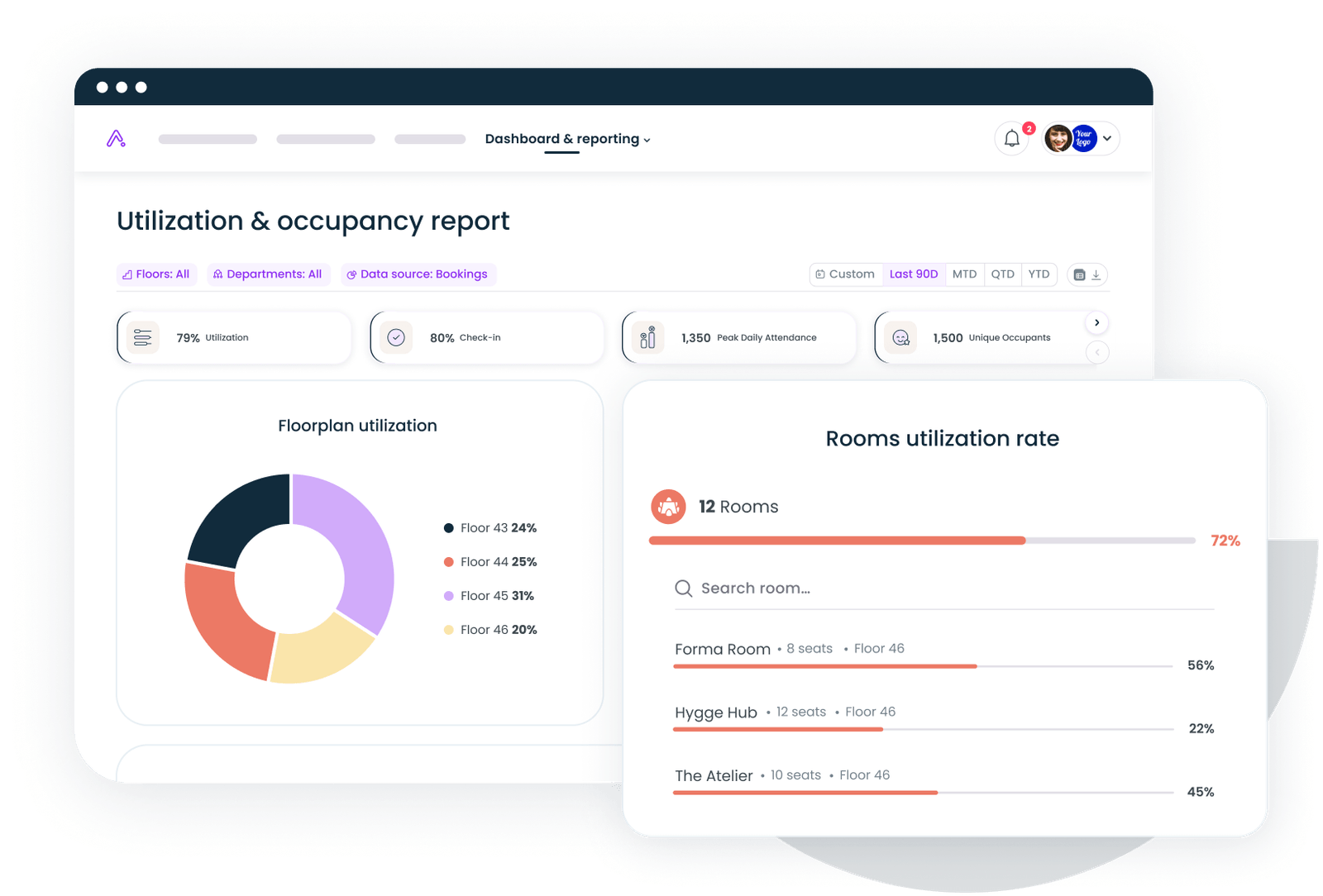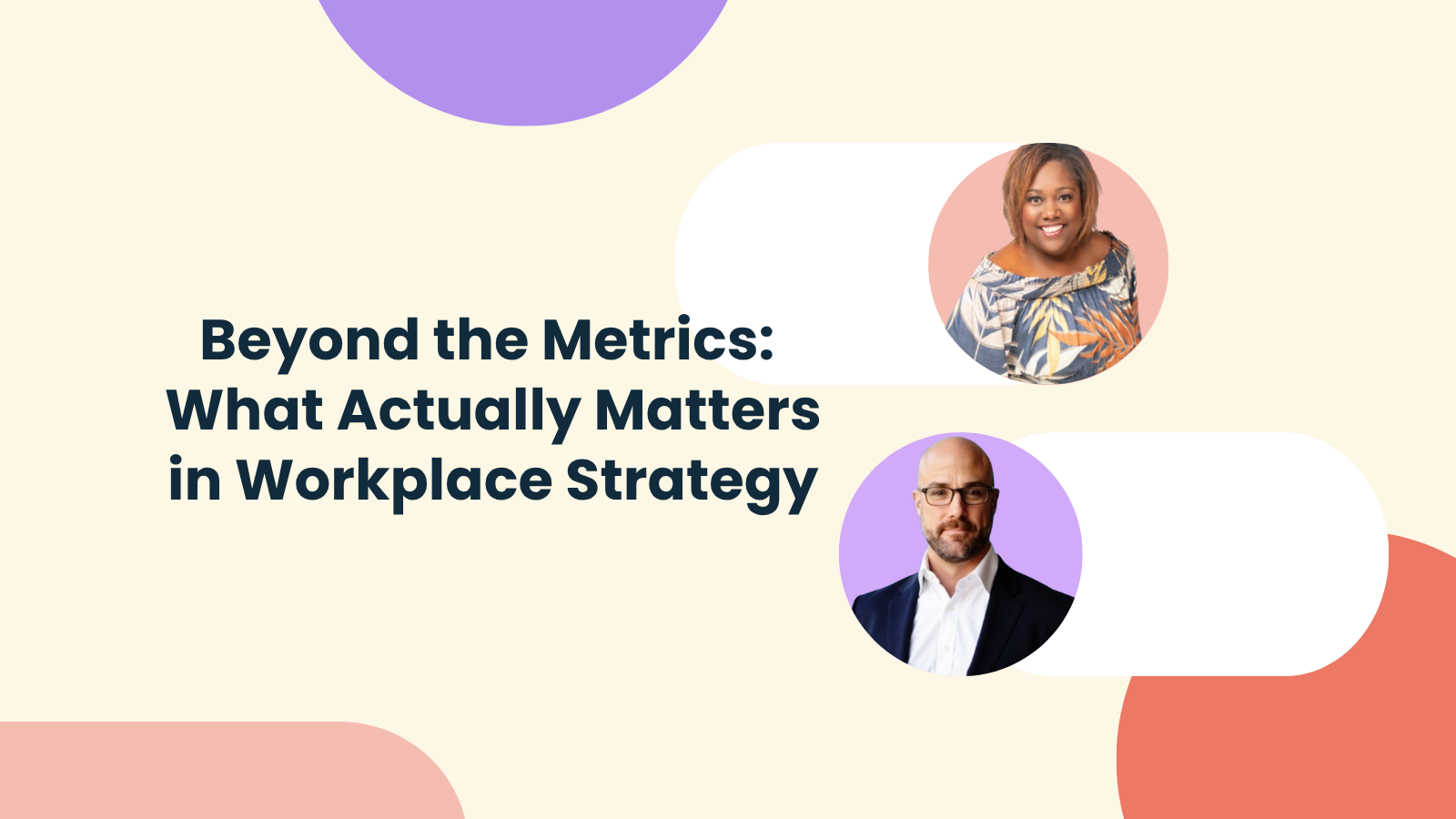Flexibility in the workplace means giving employees control over when, where, and how they work—and it's proven to reduce turnover, maintain productivity, and save companies money. This guide shows you how to implement workplace flexibility that works for both your team and your bottom line.
Flexibility has moved to a non-negotiable aspect of modern work. With 60% of remote-capable employees now preferring hybrid arrangements and organizations cutting real estate costs through flexible models, understanding what flexibility means—and how to implement it effectively—matters more than ever.
What is flexibility in the workplace
Flexibility in the workplace refers to the ability for employees to have control and autonomy over when, where, and how they complete their work. Rather than adhering to rigid 9-to-5 schedules at a traditional office, flexible work arrangements allow people to adapt their work patterns to fit both business needs and personal obligations.
At its core, a flexible workplace recognizes that different people do their best work in different ways. Some employees thrive during early morning hours, while others hit their stride in the evening. Some need quiet remote locations for focused work, while others prefer the energy of collaborative office space.
The key distinction here is that flexibility isn't just about work location. True workplace flexibility encompasses:
- Time flexibility: Employees can adjust their start and end times, work condensed schedules, or structure their hours around peak productivity
- Location flexibility: Teams can choose to work remotely, in a hybrid model, or in the office
- Method flexibility: Workers have autonomy over how they complete their tasks and how they organize their work
Research from Stanford economist Nicholas Bloom shows that when employees working hybrid schedules spend two days at home, they maintain identical productivity and promotion rates compared to full-time on site employees—while experiencing 33% lower turnover rates.
The difference between employee flexibility and workplace flexibility
Before we go further, let's clear up a common confusion. When organizations talk about flexibility at work, they're often mixing two distinct concepts:
Workplace flexibility refers to the policies, systems, and culture that employers create to enable flexible work arrangements. This includes hybrid work policies, flexible work schedules, and the tech infrastructure that enables them.
Employee flexibility describes an individual's personal flexibility.
Both matter, but they serve different purposes. You can't have successful hybrid work models without addressing both the organizational systems (workplace flexibility) and the individual capabilities (employee flexibility) that enable them.
The 5 major benefits of workplace flexibility
The data on the benefits of a flexible work environment is compelling. Organizations that get this right see measurable improvements across multiple dimensions. Here's what actually moves the needle:
1. Dramatically lower employee retention costs
Stanford's research on Trip.com found that hybrid workers were 33% less likely to resign compared to their full-time office counterparts. When you consider that replacing one employee costs 150% of their annual salary on average, the retention impact alone justifies most flexibility initiatives.
The greatest improvements show up among non-managers, women, and remote employees with longer commutes. For companies struggling to retain top talent among working parents or professionals in high-cost cities, flexible arrangements become a competitive advantage.
2. Maintained or improved productivity
One of the biggest concerns leaders have about flexibility is productivity loss, but research shows those fears are largely unfounded. Stanford's controlled study of 1,600+ employees found that hybrid work had no negative impact on performance reviews, promotion rates, or productivity measures—what the study calls a crucial finding for understanding the potential for increased productivity.
In fact, 87% of employees surveyed by McKinsey believe they're more productive when they can choose where to work. Why? Because flexibility lets people work during their peak hours, eliminates draining commutes, and enables a better work-life balance.
3. Significant costs reduction
Organizations with flexible work models report real estate savings between 10-50% as they transition from traditional long-term leases to more adaptive workspace models.
These aren't just theoretical savings. Companies using flexible office space strategies can rightsize their footprints based on usage patterns rather than maintaining expensive offices that sit partially empty most days.
4. More diverse talent pools
When you're not restricted to hiring within commuting distance of your office, you gain access to a wider talent pool. McKinsey found that workplace flexibility was the third most popular reason people cited when searching for new jobs, right behind compensation and career opportunities.
This flexibility advantage is particularly evident when trying to attract working parents, caregivers, people with disabilities, and professionals in areas with limited opportunities. Research shows that 38% of mothers with young children say they would have had to reduce hours or leave their companies entirely without flexible schedules.
5. Improved employee engagement
Gallup research shows that 80% of employees report that flexibility has improved over the past decade. This matters because disengaged employees cost organizations $8.8 trillion globally in lost productivity.
The well-being benefits extend beyond just feeling less stressed. Remote or hybrid employees report better work-life balance, improved mental health, better physical health, and higher job satisfaction. When people can schedule a doctor's appointment without burning PTO or attend a child's school event without elaborate approval processes, work feels less like an impediment to their personal life.

Not all flexible models look the same. Read this hybrid work guide to explore models that empower employees while maintaining business effectiveness.
Read the guide
How to implement workplace flexibility: 7 essential steps
Understanding the benefits of flexibility is one thing. Actually implementing it effectively is another. Here's how workplace leaders are making flexibility work in practice:
Step 1: Define your flexibility framework
Start by determining what flexibility will actually mean in your organization. Will you offer fully flex hours, or core hours when everyone should be available? How many days per week can people work from home? Are there certain roles or projects that require more in-person collaboration?
Be specific. Vague policies create confusion and inequity. A clear framework might look like: "Employees can work from home up to three days per week, with Tuesdays designated as our team collaboration day when everyone is expected in the office." The specificity removes ambiguity and creates fairness, ensuring new employees understand expectations from day one.
Step 2: Invest in new technology and the right tools
Flexibility fails without the proper technology infrastructure. You need collaboration platforms for seamless communication across time zones, space management software for desk and room booking, reliable video conferencing systems, and secure remote access to necessary systems and data.
Many companies using hybrid work software find that the coordination challenges are often more significant than the new skills needed to use the technology.
Step 3: Redesign your physical workspace
If fewer people are in the office each day, you don't need as many desks. The office's role shifts from a place where individual work happens to a hub for collaboration, culture-building, and team bonding.
Consider moving away from assigned seating toward activity-based work with more collaboration spaces, quiet zones for focused work, technology-enabled meeting rooms for hybrid meetings, and social spaces for spontaneous interactions. Companies that successfully implement hot-desking strategies often achieve 10-50% space savings while improving the employee experience.
Step 4: Establish clear expectations and communication protocols
Flexibility doesn't mean ambiguity. Set clear expectations about response times, core collaboration hours, how work gets documented and shared, and how performance gets measured when you can't see someone working. This helps give employees the structure they need to do quality work regardless of their work schedule.
Define when meetings should happen in person. Maybe brainstorming sessions and strategy planning work better face-to-face, while status updates and information sharing can happen asynchronously. Regular employee feedback helps you refine these protocols over time.
Step 5: Train managers to lead hybrid teams
Your managers probably built their leadership skills in traditional office environments. Leading flexibly distributed teams requires new skills: focusing on outcomes rather than visible activity, maintaining team cohesion across locations, preventing proximity bias in performance evaluations, and conducting effective virtual meetings.
Gallup research shows that managers account for 70% of the variance in team engagement. If your managers aren't equipped to lead flexible teams, your flexibility initiative will struggle regardless of how good your policy looks on paper. Training helps many employees in management positions adapt to this flexible work environment successfully.
Step 6: Use data to optimize and iterate
Don't guess about what's working. Track office utilization rates, employee satisfaction scores, productivity metrics, overhead costs, and turnover rates. This data helps you understand whether your flexibility approach is delivering the intended benefits while helping you benefit workers more effectively.
For example, if you notice that your office is at 80% capacity on Tuesdays but only 20% on Fridays, you might shift some required team days or adjust your real estate footprint accordingly. Companies using workplace analytics platforms make decisions based on actual usage patterns rather than assumptions, staying ahead of industry trends.
Step 7: Create a culture that embraces flexibility
The biggest challenge isn't usually the logistics—it's the culture. If leaders consistently schedule 8 AM in-person meetings, penalize people who use flexible options, or promote only those who come in every day, your stated policy doesn't matter.
Building a flexible culture means leadership modeling flexible work themselves, celebrating outcomes rather than hours logged, and actively addressing proximity bias when it appears. Companies with successful hybrid work models like Spotify and Dropbox have made flexibility a core part of their identity, not just a policy in the handbook.
Gable Offices helps teams coordinate office days, book desks & rooms, and get visibility into where colleagues will be—all in one place.
Explore Gable Offices
Common flexibility challenges and how to offer solutions
Even well-planned flexibility initiatives hit obstacles. Here's how to stay flexible when facing the most common challenges workplace leaders encounter:
Challenge: Collaboration feels harder when teams are distributed
The problem: Spontaneous hallway conversations disappear. Projects take longer when you can't just tap someone's shoulder. Team bonding suffers when people rarely see each other.
The solution: Make office days intentional rather than arbitrary. When your team comes in, ensure it's for activities that genuinely benefit from face-to-face interaction—brainstorming, strategy sessions, team building. Use collaboration platforms for asynchronous work so people can contribute regardless of location or time zones. Research shows face-to-face collaboration generates 15-20% more ideas during creative work, so optimize for that advantage.
Challenge: Measuring performance without visibility
The problem: If you can't see people working, how do you know they're actually working? Managers worry about accountability.
The solution: Shift from measuring inputs (hours logged, presence) to measuring outputs (projects completed, goals achieved, quality work delivered). Set clear objectives and key results. Check in regularly on progress. When Stanford studied hybrid workers, they found identical performance review scores and promotion rates compared to office workers because the companies focused on what got done, not where it happened.
Challenge: Not all roles can be equally flexible
The problem: Your customer support team needs specific coverage hours. Your facilities team needs to be on site. Your engineering team can work from anywhere. How do you create equity when two employees in different roles have different flexibility options?
The solution: Different doesn't mean unfair. Be transparent about why certain roles have different arrangements. Ensure that career opportunities and compensation aren't tied to flexibility levels. Find creative ways to provide employees with flexibility within constraints—compressed schedules like a four day workweek, schedule swaps, or flexible break times for roles that require specific presence.
Challenge: Company culture feels diluted
The problem: New employees struggle to understand "how things work here." Team connections feel transactional. The sense of shared purpose fades.
The solution: Culture doesn't happen accidentally in a flexible work environment—you have to build it deliberately. Create structured opportunities for connection: regular team rituals, quarterly all-hands gatherings, and employee engagement activities that happen both virtually and in-person. Document your culture explicitly so it's accessible to everyone, not just those who happen to overhear office conversations.
Challenge: Coordination complexity
The problem: You need to meet with five people, but they're all working different schedules. Someone books the conference room you needed. Nobody knows who's in the office when.
The solution: Implement workspace management tools that show availability, enable easy booking, and coordinate schedules. Establish team norms—maybe Tuesdays are always collaboration days, or teammates share their weekly plans every Monday. Platforms like Gable help teams coordinate naturally without constant back-and-forth negotiation.
Real-world flexibility examples
Let's look at how different organizations have implemented workplace flexibility successfully:
Stanford University's research model: Trip.com (one of the world's largest online travel agencies) implemented a controlled hybrid trial where employees working the hybrid schedule spent time at home on Wednesdays and Fridays while coming to the office Monday, Tuesday, and Thursday. The result? 33% lower turnover, maintained productivity, and millions in savings.
Three-day hybrid standard: Companies like Google have settled on a Tuesday-Wednesday-Thursday in-office schedule, with Monday and Friday flexible. This gives teams mid-week collaboration time while acknowledging that Fridays show 28% office utilization anyway.
Fully flexible with coordination: Spotify's "Work From Anywhere" policy puts employees in control but emphasizes intentional coordination. Teams decide together when in-person time adds value rather than following mandates.
Neighborhood-based approaches: Some companies create team-based office neighborhoods where employees share workspace when they're in, making spontaneous collaboration easier while maintaining flexibility.
The common thread? Successful flexibility is intentional, coordinated, and purpose-driven. It's not about everyone doing whatever they want whenever they want—it's about structuring flexibility in ways that serve both business objectives and personal needs.
Coordinate flexible teams, optimize office spaces, and make data-driven real estate decisions. See how companies use Gable to turn flexibility into a competitive advantage.
Get a demo





.svg)





.svg)
















.svg)












